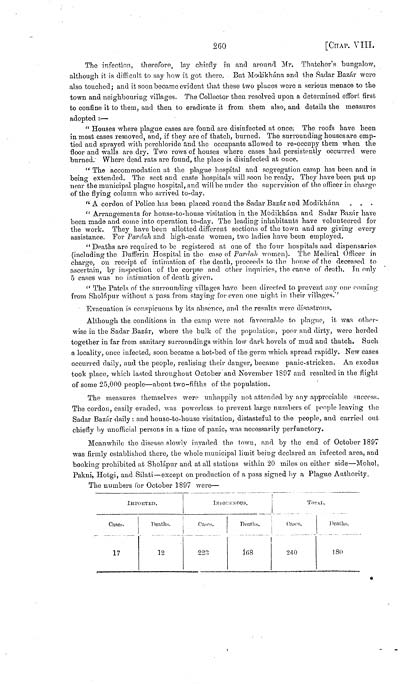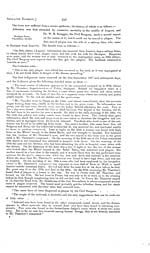Medicine - Disease > Bombay plague: being a history of the progress of plague in the Bombay presidency from September 1896 to June 1899
(334) Page 260
Download files
Individual page:
Thumbnail gallery: Grid view | List view

260 [CHAP. VIII.
The infection, therefore, lay chiefly in and around Mr. Thatcher's bungalow,
although it is difficult to say how it got there. But Modikhna and the Sadar Bazr were
also touched; and it soon became evident that these two places were a serious menace to the
town and neighbouring villages. The Collector then resolved upon a determined effort first
to confine it to them, and then to eradicate it from them also, and details the measures
adopted :-
" Houses where plague cases are found are disinfected at once: The roofs have been
in most cases removed, and, if they are of thatch, burned. The surrounding houses are emp-
tied and sprayed with perchloride and the occupants allowed to re-occupy them when the
floor and walls are dry. Two rows of houses where cases had persistently occurred were
burned. Where dead rats are found, the place is disinfected at once.
" The accommodation at the plague hospital and segregation camp has been and is
being extended. The sect and caste hospitals will soon be ready. They have been put up
near the municipal plague hospital, and will be under the supervision of the officer in charge
of the flying column who arrived to-day.
" A cordon of Police has been placed round the Sadar Bazr and Modikhna
" Arrangements for house-to-house visitation in the Modikhna and Sadar Bzar have
been made and come into operation to-day. The leading inhabitants have volunteered for
the work. They have been allotted different sections of the town and are giving every
assistance. For Pardah and high-caste women, two ladies have been employed.
" Deaths are required to be registered at one of the four hospitals and dispensaries
(including the Dufferin Hospital in the case of Pardah women). The Medical Officer in
charge, on receipt of intimation of the death, proceeds to the house of the deceased to
ascertain, by inspection of the corpse and other inquiries, the cause of death. In only
5 cases was no intimation of death given.
"The Patels of the surrounding villages have been directed to prevent any one coming
from Sholpur without a pass from staying for even one night in their villages."
Evacuation is conspicuous by its absence, and the results were disastrous.
Although the conditions in the camp were not favourable to plague, it was other-
wise in the Sadar Bzar, where the bulk of the population, poor and dirty, were herded
together in far from sanitary surroundings within low dark hovels of mud and thatch. Such
a locality, once infected, soon became a hot-bed of the germ which spread rapidly. New cases
occurred daily, and the people, realising their danger, became panic-stricken. An exodus
took place, which lasted throughout October and November 1897 and resulted in the flight
of some 25,000 people-about two-fifths of the population.
The measures themselves were unhappily not attended by any appreciable success.
The cordon, easily evaded, was powerless to prevent large numbers of people leaving the
Sadar Bzar daily : and house-to-house visitation, distasteful to the people, and carried out
chiefly by unofficial persons in a time of panic, was necessarily perfunctory.
Meanwhile the disease slowly invaded the town, and by the end of October 1897
was firmly established there, the whole municipal limit being declared an infected area, and
booking prohibited at Sholpur and at all stations within 20 miles on either side-Mohol,
Pakni, Hotgi, and Silati-except on production of a pass signed by a Plague Authority.
The numbers for October 1897 were-
IMPORTED.
INDIGENOUS
TOTAL.
Cases.
Deaths.
Case.
Deaths.
Cases.
Deaths
17
12
223
168
240
180
The infection, therefore, lay chiefly in and around Mr. Thatcher's bungalow,
although it is difficult to say how it got there. But Modikhna and the Sadar Bazr were
also touched; and it soon became evident that these two places were a serious menace to the
town and neighbouring villages. The Collector then resolved upon a determined effort first
to confine it to them, and then to eradicate it from them also, and details the measures
adopted :-
" Houses where plague cases are found are disinfected at once: The roofs have been
in most cases removed, and, if they are of thatch, burned. The surrounding houses are emp-
tied and sprayed with perchloride and the occupants allowed to re-occupy them when the
floor and walls are dry. Two rows of houses where cases had persistently occurred were
burned. Where dead rats are found, the place is disinfected at once.
" The accommodation at the plague hospital and segregation camp has been and is
being extended. The sect and caste hospitals will soon be ready. They have been put up
near the municipal plague hospital, and will be under the supervision of the officer in charge
of the flying column who arrived to-day.
" A cordon of Police has been placed round the Sadar Bazr and Modikhna
" Arrangements for house-to-house visitation in the Modikhna and Sadar Bzar have
been made and come into operation to-day. The leading inhabitants have volunteered for
the work. They have been allotted different sections of the town and are giving every
assistance. For Pardah and high-caste women, two ladies have been employed.
" Deaths are required to be registered at one of the four hospitals and dispensaries
(including the Dufferin Hospital in the case of Pardah women). The Medical Officer in
charge, on receipt of intimation of the death, proceeds to the house of the deceased to
ascertain, by inspection of the corpse and other inquiries, the cause of death. In only
5 cases was no intimation of death given.
"The Patels of the surrounding villages have been directed to prevent any one coming
from Sholpur without a pass from staying for even one night in their villages."
Evacuation is conspicuous by its absence, and the results were disastrous.
Although the conditions in the camp were not favourable to plague, it was other-
wise in the Sadar Bzar, where the bulk of the population, poor and dirty, were herded
together in far from sanitary surroundings within low dark hovels of mud and thatch. Such
a locality, once infected, soon became a hot-bed of the germ which spread rapidly. New cases
occurred daily, and the people, realising their danger, became panic-stricken. An exodus
took place, which lasted throughout October and November 1897 and resulted in the flight
of some 25,000 people-about two-fifths of the population.
The measures themselves were unhappily not attended by any appreciable success.
The cordon, easily evaded, was powerless to prevent large numbers of people leaving the
Sadar Bzar daily : and house-to-house visitation, distasteful to the people, and carried out
chiefly by unofficial persons in a time of panic, was necessarily perfunctory.
Meanwhile the disease slowly invaded the town, and by the end of October 1897
was firmly established there, the whole municipal limit being declared an infected area, and
booking prohibited at Sholpur and at all stations within 20 miles on either side-Mohol,
Pakni, Hotgi, and Silati-except on production of a pass signed by a Plague Authority.
The numbers for October 1897 were-
IMPORTED.
INDIGENOUS
TOTAL.
Cases.
Deaths.
Case.
Deaths.
Cases.
Deaths
17
12
223
168
240
180
Set display mode to: Large image | Zoom image | Transcription
Images and transcriptions on this page, including medium image downloads, may be used under the Creative Commons Attribution 4.0 International Licence unless otherwise stated. ![]()
| India Papers > Medicine - Disease > Bombay plague: being a history of the progress of plague in the Bombay presidency from September 1896 to June 1899 > (334) Page 260 |
|---|
| Permanent URL | https://digital.nls.uk/74586636 |
|---|




